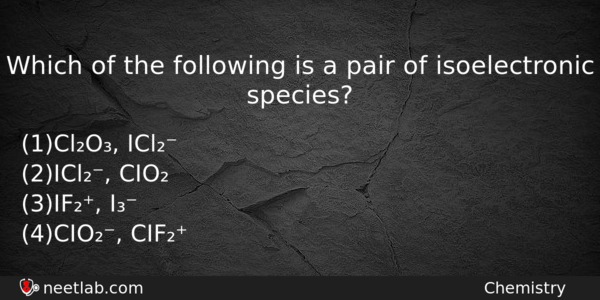| ⇦ | 
| ⇨ |
Which of the following is a pair of isoelectronic species?
Options
(a) Cl₂O₃, ICl₂⁻
(b) ICl₂⁻, CIO₂
(c) IF₂⁺, I₃⁻
(d) CIO₂⁻, CIF₂⁺
Correct Answer:
CIO₂⁻, CIF₂⁺
Explanation:
Number of electrons in CIO₂⁻ = 17+ 16+ 1 = 34 electrons.
Number of electrons in CIF₂⁺ = 17+ 18- 1 = 34 electrons.
Hence, CIO₂⁻ and CIF₂⁺ are isoelectronic species.
Related Questions: - An equation is given as:SnO₂ + C → Sn + CO.Its balanced form will involve
- Which of the following can act as both oxidising and reducing agents
- Which of the following is obtained when auric chloride reacts with sodium
- Zeolite used to soften hardness of water is, hydrated
- An increase in equivalent conductance of a strong electrolyte
Question Type: Memory
(964)
Difficulty Level: Easy
(1008)
Topics: Structure of Atom
(90)
Subject: Chemistry
(2512)
Important MCQs Based on Medical Entrance Examinations To Improve Your NEET Score
- An equation is given as:SnO₂ + C → Sn + CO.Its balanced form will involve
- Which of the following can act as both oxidising and reducing agents
- Which of the following is obtained when auric chloride reacts with sodium
- Zeolite used to soften hardness of water is, hydrated
- An increase in equivalent conductance of a strong electrolyte
Question Type: Memory (964)
Difficulty Level: Easy (1008)
Topics: Structure of Atom (90)
Subject: Chemistry (2512)
Important MCQs Based on Medical Entrance Examinations To Improve Your NEET Score
18000+ students are using NEETLab to improve their score. What about you?
Solve Previous Year MCQs, Mock Tests, Topicwise Practice Tests, Identify Weak Topics, Formula Flash cards and much more is available in NEETLab Android App to improve your NEET score.
Share this page with your friends

Leave a Reply